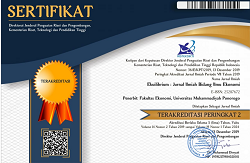Unsystematic Risk Management based on Financial Literacy as a Supporting Factor in Investment Decisions
DOI: 10.24269/ekuilibrium.v19i1.2024.pp136-148
Abstract
This research examines financial literacy's influence on investment decisions through unsystematic risk management. The data source used in this research is primary data obtained through a questionnaire. The sampling technique used was purposive sampling, using sample criteria to enter as a research sample. This research involved 88 respondents as research samples. The analytical tool used to carry out statistical tests is SmartPLS. This study found that financial literacy and unsystematic risk management simultaneously had a significant positive effect on investment decisions. Unsystematic risk management has a significant positive effect on investment decisions. Furthermore, unsystematic risk management can mediate the relationship between financial literacy and investment decisions. This study highlights investor behavior in making investment decisions using the theory of planned behavior approach.
Keywords
References
- Ahmad, M. (2020). Does underconfidence matter in short-term and long-term investment decisions? Evidence from an emerging market. Management Decision, 59(3), 692–709. https://doi.org/10.1108/MD-07-2019-0972
- Ahmad, M., & Shah, S. Z. A. (2022). Overconfidence heuristic-driven bias in investment decision-making and performance: mediating effects of risk perception and moderating effects of financial literacy. Journal of Economic and Administrative Sciences, 38(1), 60–90. https://doi.org/10.1108/jeas-07-2020-0116
- Ajzen, I. (1991). The Theory of Planned Behavior.
- Ajzen, I. (2002). Perceived Behavioral Control , Self-Efficacy , Locus of Control , and the Theory of Planned Behavior1. Journal OfApplied Social Psychology, 665–683.
- Antony, A., & Joseph, A. I. (2019). Influence of Behavioural Factors Affecting Investment Decision — An AHP Analysis. December 2017. https://doi.org/10.1177/0972622517738833
- Awais, M., Fahad Laber, M., Rasheed, N., & Khursheed, A. (2016). International Journal of Economics and Financial Issues Impact of Financial Literacy and Investment Experience on Risk Tolerance and Investment Decisions: Empirical Evidence from Pakistan. International Journal of Economics and Financial Issues, 6(1), 73–79. http:www.econjournals.com
- Baker, H. K., & Filbeck, G. (2015). Investment Risk Management.
- Baker, H. K., Kumar, S., Goyal, N., & Gaur, V. (2019). How financial literacy and demographic variables relate to behavioral biases. Managerial Finance, 45(1), 124–146. https://doi.org/10.1108/MF-01-2018-0003
- Bello, & Zakri. (2005). Idiosyncratic risk and mutual fund return. The Journal of Business and Economic Studies, 11(2).
- Bikhchandani, S., Hirshleife, D., & Welch, I. (1992). A Theory of Fads , Fashion , Custom , and Cultural Change as Informational Cascades. Journal of Political Economy, 100(5), 992–1026.
- Dhar, R., & Zhu, N. (2006). Up close and personal: Investor sophistication and the disposition effect. Management Science, 52(5), 726–740. https://doi.org/10.1287/mnsc.1040.0473
- Falahati, L., Sabri, M. F., & Paim, L. H. J. (2012). Assessment a model of financial satisfaction predictors: Examining the mediate effect of financial behaviour and financial strain. World Applied Sciences Journal, 20(2), 190–197. https://doi.org/10.5829/idosi.wasj.2012.20.02.1832
- Finucane, M. L., Alhakami, A., Slovic, P., & Johnson, S. M. (2000). The affect heuristic in judgments of risks and benefits. Journal of Behavioral Decision Making, 13(1), 1–17. https://doi.org/10.1002/(SICI)1099-0771(200001/03)13:1<1::AID-BDM333>3.0.CO;2-S
- Firer, C. ; Ross, S. A., Westerfield, R. W., & Jordan, B. D. (2008). Fundamentals of Corporate Finance.
- Forlani, D., & Mullins, J. W. (2000). Perceived risks and choices in entrepreneurs’ new venture decisions. Journal of Business Venturing, 15(4), 305–322. https://doi.org/10.1016/S0883-9026(98)00017-2
- Ganesan, Y., Allah Pitchay, A. Bin, & Mohd Nasser, M. A. (2020). Does intention influence the financial literacy of depositors of Islamic banking? A case of Malaysia. International Journal of Social Economics, 47(5), 675–690. https://doi.org/10.1108/IJSE-01-2019-0011
- Gärling, T., Kirchler, E., Lewis, A., & van Raaij, F. (2009). Psychology, Financial Decision Making, and Financial Crises. Psychological Science in the Public Interest, Supplement, 10(1), 1–47. https://doi.org/10.1177/1529100610378437
- Ghozali, I. (2014). Partial Least Squares (Konsep, Teknik dan Aplikasi SmartPLS 3,0). Universitas Diponegoro.
- Gupta, P. K. (2011). Risk management in Indian companies: EWRM concerns and issues. Journal of Risk Finance, 12(2), 121–139. https://doi.org/10.1108/15265941111112848
- Hamza, N., & Arif, I. (2019). Impact of Financial Literacy on Investment Decisions : The Mediating Effect of Big-Five Personality Traits Model. June.
- Hassan Al-Tamimi, H. A., & Anood Bin Kalli, A. (2009). Financial literacy and investment decisions of UAE investors. Journal of Risk Finance, 10(5), 500–516. https://doi.org/10.1108/15265940911001402
- Hoffmann, A. O. I., & Post, T. (2017). How return and risk experiences shape investor beliefs and preferences. Accounting and Finance, 57(3), 759–788. https://doi.org/10.1111/acfi.12169
- Huston, S. J. (2010). Measuring Financial Literacy. Journal of Consumer Affairs, 44(2), 296–316. https://doi.org/10.1111/j.1745-6606.2010.01170.x
- Jackson, J. (2010). Promoting energy efficiency investments with risk management decision tools. Energy Policy, 38(8), 3865–3873. https://doi.org/10.1016/j.enpol.2010.03.006
- Jorion, P. (2001). alue at Risk: The New Benchmark for Managing Financial Risk (2nd Editio). McGraw-Hil.
- Junianto, Y., Kohardinata, C., & Silaswara, D. (2020). Financial Literacy Effect and Fintech in Investment Decision Making. Primanomics: Jurnal Ekonomi & Bisnis, 18(3), 150–168.
- Kasoga, P. S. (2021). Heuristic biases and investment decisions: multiple mediation mechanisms of risk tolerance and financial literacy—a survey at the Tanzania stock market. Journal of Money and Business, 1(2), 102–116. https://doi.org/10.1108/jmb-10-2021-0037
- Lam, J. (2001). Enterprise Risk Management: From Incentives to Controls, 2nd Edition.
- Li, X., Miffre, J., Brooks, C., & O’Sullivan, N. (2008). Momentum profits and time-varying unsystematic risk. Journal of Banking and Finance, 32(4), 541–558. https://doi.org/10.1016/j.jbankfin.2007.03.014
- Li, X., & Wu, Z. (2008). Reputation entrenchment or risk minimization?: Early stop and investor-manager agency conflict in fund management. Journal of Risk Finance, 9(2), 125–150. https://doi.org/10.1108/15265940810853904
- Li, X., & Wu, Z. (2009). Corporate risk management and investment decisions. Journal of Risk Finance, 10(2), 155–168. https://doi.org/10.1108/15265940910938233
- Lusardi, A., & Mitchell, O. S. (2014). The economic importance of financial literacy: Theory and evidence. Journal of Economic Literature, 52(1), 5–44. https://doi.org/10.1257/jel.52.1.5
- Merková, M., & Drábek, J. (2015). Use of Risk Analysis in Investment Measurement and Management. Procedia Economics and Finance, 34(15), 656–662. https://doi.org/10.1016/s2212-5671(15)01682-2
- Mouna, A., & Anis, J. (2017). Financial literacy in Tunisia: Its determinants and its implications on investment behavior. Research in International Business and Finance, 39, 568–577. https://doi.org/10.1016/j.ribaf.2016.09.018
- Mushinada, V. N. C. (2020). Are individual investors irrational or adaptive to market dynamics? Journal of Behavioral and Experimental Finance, 25. https://doi.org/10.1016/j.jbef.2019.100243
- Mwathi, A. W., Kubasu, A., & Akuno, R. (2017). Effects of Financial Literacy on Personal Financial Decisions among Egerton University Employees , Nakuru. 5(3), 173–181. https://doi.org/10.11648/j.ijefm.20170503.16
- Paquin, J. P., Gauthier, C., & Morin, P. P. (2016). The downside risk of project portfolios: The impact of capital investment projects and the value of project efficiency and project risk management programmes. International Journal of Project Management, 34(8), 1460–1470. https://doi.org/10.1016/j.ijproman.2016.07.009
- Patil, S., & Bagodi, V. (2021). “A study of factors affecting investment decisions in India: The KANO way.” Asia Pacific Management Review, 26(4), 197–214. https://doi.org/10.1016/j.apmrv.2021.02.004
- Rahman, M., & Gan, S. S. (2020). Generation Y investment decision: an analysis using behavioural factors. Managerial Finance, 46(8), 1023–1041. https://doi.org/10.1108/MF-10-2018-0534
- Renn, O. (1998). Three decades of risk research : Accomplishments and new challenges. Journal of Risk Research, 1(1), 49–71.
- Riawan. (2023). Peran Islamic Ethics Financial Behavior Dan Unsystematic Risk Management Dalam Investment Decision. Universitas Islam Sultan Agung Semarang.
- Rosman, R., & Rahman, A. R. A. (2015). The practice of IFSB guiding principles of risk management by Islamic banks. The Eletronic Library, 6(2), 150–172.
- Sabir, S. A., Mohammad, H. Bin, & Shahar, H. B. K. (2019). The role of overconfidence and past investment experience in herding behaviour with a moderating effect of financial literacy: Evidence from pakistan stock exchange. Asian Economic and Financial Review, 9(4), 480–490. https://doi.org/10.18488/journal.aefr.2019.94.480.490
- Saputra, R. F., Suyanto, S., & Japlani, A. (2021). Pengaruh Literasi Keuangan Terhadap Minat Berinvestasi di Pasar Modal Dengan Perkembangan Teknologi Digital Sebagai Variabel Moderasi (Studi Empiris Mahasiswa Akuntansi Universitas Muhammadiyah Metro). Jurnal Akuntansi AKTIVA, 2(2), 196–203. http://scholar.ummetro.ac.id/index.php/aktiva/article/view/1543
- Sashikala, V., & Chitramani, P. (2018). The Impact of Behavioural Factors on Investment Intention of Equity Investors. Asian Journal of Management., 09(01). https://doi.org/10.5958/2321-5763.2018.00028.8
- Sathiyamurthi, K., Devi, K., & Raj, A. N. (2021). Materials Today : Proceedings Computational analysis and intelligence for mediating effect of investment knowledge on investment intention and investment behaviors. Materials Today: Proceedings, xxxx, 1–5. https://doi.org/10.1016/j.matpr.2021.01.062
- Servon, L. J., & Kaestner, R. (2008). Consumer financial literacy and the impact of online banking on the financial behavior of lower-income bank customers. Journal of Consumer Affairs, 42(2), 271–305. https://doi.org/10.1111/j.1745-6606.2008.00108.x
- Shah, S. Z. A., Ahmad, M., & Mahmood, F. (2018). Heuristic biases in investment decision-making and perceived market efficiency: A survey at the Pakistan stock exchange. Qualitative Research in Financial Markets, 10(1), 85–110. https://doi.org/10.1108/QRFM-04-2017-0033
- Shukla, A., Rushdi, N. J., & Katiyar, R. C. (2020). Impact of behavioral biases on investment decisions ‘a systematic review.’ International Journal of Management, 11(4), 68–76. https://doi.org/10.34218/IJM.11.4.2020.009
- Sindhu, R., Jandail, R. R. S., & Kumar, R. (2014). A Novel Approach for Sentiment Analysis and Opinion Mining. International Journal of Emerging Technology and Advanced Engineering, 4(4), 522–527.
- Slovic, P. (1999). Trust, emotion, sex, politics and science: Surveying the risk-assessment battlefield. The Perception of Risk, 19(4), 390–412. https://doi.org/10.1111/j.1539-6924.1999.tb00439.x
- Songling, Y., Ishtiaq, M., & Anwar, M. (2018). Enterprise Risk Management Practices and Firm Performance, the Mediating Role of Competitive Advantage and the Moderating Role of Financial Literacy. Journal of Risk and Financial Management, 11(3), 35. https://doi.org/10.3390/jrfm11030035
- Thomas, A., & Spataro, L. (2018). Financial Literacy, Human Capital and Stock Market Participation in Europe. In Journal of Family and Economic Issues (Vol. 39, Issue 4). https://doi.org/10.1007/s10834-018-9576-5
- van Rooij, M., Lusardi, A., & Alessie, R. (2011). Financial literacy and stock market participation. Journal of Financial Economics, 101(2), 449–472. https://doi.org/10.1016/j.jfineco.2011.03.006
- Widiyastuti, A., & Nashirudin, M. (2022). Faktor Penyebab Rendahnya Minat Mahasiswa Untuk Berinvestasi. Jurnal Justisia Ekonomika: Magister Hukum Ekonomi Syariah, 6(1). https://doi.org/10.30651/justeko.v6i1.13331
- Xiang, C. Y. (2014). The Influence of Behavioral Factors in Making Investment Decisions and Performance: Study on Investors of Colombo Stock Exchange, Sri Lanka. Asian Journal of Finance & Accounting, 6(1).
- Xiao, J. J., Chen, C., & Chen, F. (2014). Consumer financial capability and financial satisfaction. Social Indicators Research, 118(1), 415–432. https://doi.org/10.1007/s11205-013-0414-8
Refbacks
- There are currently no refbacks.

This work is licensed under a Creative Commons Attribution-ShareAlike 4.0 International License.













